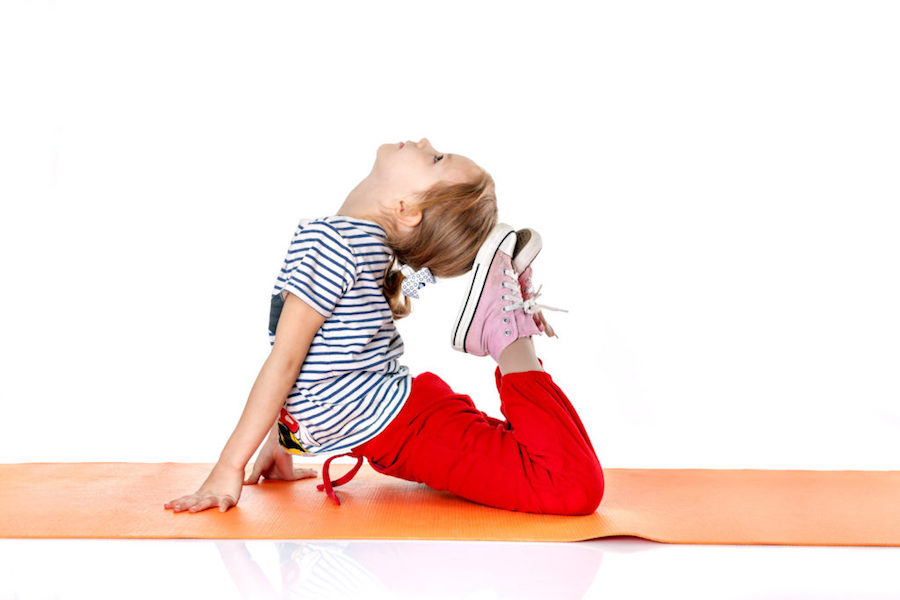
If your child is experiencing stress, anxiety or bullying at school, these issues can emerge as ‘stomach pain.’ Introducing your child to yoga poses can have a positive effect on these challenges.
But there are also physical reasons why kids might have stomach pain. Infections, poor nutrition, constipation, and acid reflux can give rise to chronic abdominal pain. This pain can affect a child’s ability to attend school, play sports and perform day-to-day activities.
While you are getting to the root of what’s causing the pain, introducing your child to yoga poses can not only eliminate the pain but will teach them the benefits of breathing, stretching and yoga itself. Although medications can have an immediate effect on stomach pain, gentle movements will calm the body and provide long-lasting relief. The process of breathing while performing yoga movements relaxes muscles and brings oxygen to the abdominal area. Read more about the benefits of Yoga for Kids in my blog article titled Yoga Helps Kids Sleep.
Introducing your child to yoga poses:
Seated Forward Fold Pose (Paschimottanasana): Let the child sit on a yoga mat or the floor with an erect spine and extended legs. Fold at the hips keeping the back straight as long as possible. Rest the hands on the thighs, shins, or feet depending on your child’s comfort level. Bring the forehead over the thighs and breathe slowly. Advise them to hold this posture for 30 seconds or more.
Benefit: An incredibly calming posture that reduces stress, improves digestion and cures digestion-related problems.
Standing Forward Bend Pose (Uttanasana): Instruct your child to stand on the ground with feet hip-width apart. Inhale, raise the hands overhead and upon exhalation bend forward. Bring the arms down and place the palms on the floor beside each foot. Allow them to retain the pose for 20-30 seconds.
Benefit: The pose activates the abdominal muscles, enhances digestion and promotes better functioning of other organs.
Child Pose (Balasana): Let your child kneel on a yoga mat or floor. Relax the torso and slightly spread the knees. Fold forward and bring the forehead to rest on the ground. Stretch the arms backward while keeping the palms in an upward direction. Kids can stay in this pose for 20-30 seconds.
Benefit: The posture massages the stomach and the compression stimulates the stagnant digestive system.
Half Lord Of the Fishes Pose (Ardha Matsyendrasana): Ask your child to sit upright on the floor. Bend the knees and lay the left foot to the outside of the right posterior. Cross the right leg over left and rest the foot near the left knee. Locate the right hand behind the hip like a tripod and rest the left hand on the right knee. Twist to the right and look over the shoulders. Advise the children to retain the posture for around 30 seconds.
Benefit: The twists activates the unhappy digestive tract, remove stuck material, and promote better digestion.
Wind-Relieving Pose (Pawanmuktasana): Ask your child to lie on a yoga mat or floor. Bend the knees and draw it to the chest. While holding the left knee in place, instruct them to extend the right leg to the floor. Now, hold the right knee towards the chest and release the left leg. Encourage them to repeat the movements 15-20 times and finally relax in lying position.
Benefit: The yoga asana powerfully releases all the trapped gases in the stomach and eases belly pain.
[Tweet “If your child is experiencing stress, anxiety or bullying at school, these issues can emerge as stomach pain.”]
Bridge Pose (Setu-Bandhasana): Instruct your child to lie on their back. Bend the knees and press the arms into the floor. Gently, lift the back and hips off the floor. Broaden the shoulder blades and relax the head. Instruct your child to stay in this posture for 30-60 seconds.
Benefit: The pose stretches and stimulates the organs thus improving digestion and enhancing the blood flow.
Corpse Pose (Savasana): Finally, ask your child to lie peacefully on the ground and to relax the body. Loosen up your legs, arms, and keep the eyes closed. Breathe softly and advise the child to remain in this pose for 5 minutes.
Benefit: A relaxing posture that brings the body into a state of balance and results in its optimal working. Read more about proper yoga breathing on the blog article titled How to improve your breathing.
Encourage your children to practice some or all of these yoga poses on a daily basis. These poses will not only address the physical issues associated with stomach pain but will create a foundation for a healthy body and mind. Join your child in performing these poses and experience the benefits yourself.
Teach kids yoga breathing listening or reading Sea Otter Cove.
Manmohan Singh is a passionate Yogi, Yoga Teacher and a Traveller in India. He provides yoga teacher training in Rishikesh, India. He loves writing and reading the books related to yoga, health, nature and the Himalayas. For more information about him visit his website.